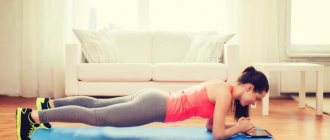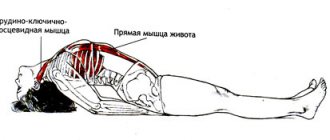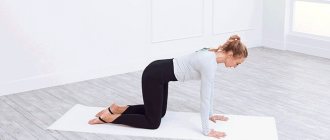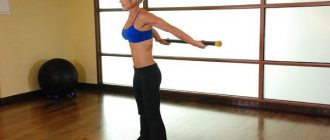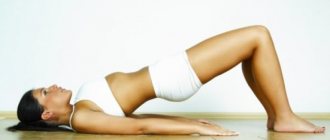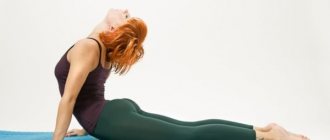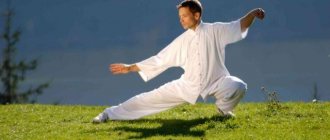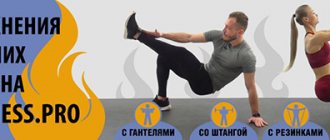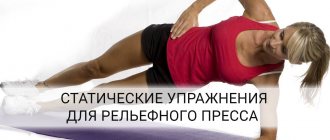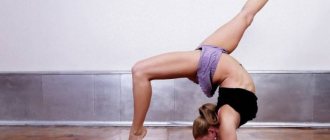The mechanism of the influence of yoga on the human body
Today, a sore back is a common sign of anxiety at any age.
Yoga can (and should) be used as physical therapy for the back and spine, as well as simply as a means of relaxation. Yoga influences human energy
Types of effects of yoga on the human body:
- Mechanical impact. A significant portion of the asanas engage not only the majority of the muscles, but also those muscles that are not usually used on a daily basis. They involve specific muscle groups and have a mechanical effect on the internal organs of a person through non-standard changes in body shape.
- Humoral effects. The exact sciences of physics and chemistry represent the human body as a collection of vessels filled with various liquids and gases. Yogic asanas allow for their specific hydraulic massage.
- Psychosomatic effects. It's no secret that the psyche is very closely connected with the human body. If you influence the body in any way, you can make changes in your state of mind.
- Stressful impact. Most yoga poses are unnatural for the body. Each asana puts the human body into a stressful state through an unusual body position. However, too much stress has the opposite effect and you need to know when to stop.
- Hormonal influence. Some asanas have a beneficial effect on the endocrine glands by changing the intensity of blood flow, thereby stimulating their work.
- Energy impact. The subject of influence of asanas is human energy. They direct energy in the right direction and give a person strength.
Yoga and spine
The straight position of the human spine from a physiological point of view. is not its natural state. In fact, every day this part of the body experiences enormous stress, which over time causes a series of abnormal configurations in the structure of the back.
This is the destruction of spinal discs, muscle weakness and other problems. Even the spinal cord, which is an integral part of the nervous system, suffers from lack of muscle tension in the back. But those who practice yoga exercises believe that even the simplest muscle efforts, their light weight and stretching can be an excellent remedy for old age and illness.
All back exercises associated with yoga are based on taking a certain asana and holding it for some time. Thanks to this, you can reduce pressure on the intervertebral discs, improve joint mobility, and strengthen muscles. Yoga not only increases a person's physical strength, but also their flexibility.
There is a very perfect and effective set of yoga exercises for solving back problems - Zyung Xinh or the Vietnamese version.
This type of yoga is intended only for the treatment of the back and spine. A characteristic feature is that all exercises are performed in a lying position. In addition, the system has its own breathing functions, divided into 4 phases.
Here are the basic exercises:
- The practitioner intensely presses the shoulder blades and feet to the floor, strongly bending the spine. Staying in this state is suitable for 20 seconds, while you need to sway slightly to the sides and breathe evenly.
- The second exercise is very similar to the first, but now you also need to press your elbows to the floor. In this case, the abdominal cavity should be directed downwards and the spine should be directed backwards, that is, upwards.
- The yogi does a regular butterfly, spreading his knees as far as possible to the side, but lying down.
- You need to smoothly raise your straight legs to the ceiling, and then equally slowly lower them behind your head. The result is a contorted pose that perfectly stretches the vertebrae.
- Now you can push your knees apart, trying to pull your toes and push your pelvis forward. But don't overdo it - you might just lose your balance and get injured.
We invite you to familiarize yourself with the Dream Interpretation of a railway in a dream, why do you dream of a railway?
The complex is very useful and suitable for almost all age categories. The time required to perform is comparable to other asana complexes.
The benefits of yoga for the health of the spine and back
All asanas are performed statically. When a person takes any position, the pressure inside the intervertebral discs becomes less, and the degree of mobility of all parts of the spine increases.
People who regularly practice yoga in their lives have fewer health problems, including back pain, and, accordingly, look better. People who exercise daily have a strong, healthy and flexible back.
Yoga trains muscles
Yoga has the following effects on the back:
- stretches the spine, increases flexibility, promotes its straightening;
- works the back and neck muscles, which prevents the development of back diseases;
- relaxes tense muscles;
- relieves internal tension, improves mood;
- nourishes the body's cells with oxygen, renews cells, preserves youth through measured and deep breathing;
- makes the back straight, improves posture, reduces curvature;
- increases the mobility of each vertebra;
- strengthens the walls of blood vessels;
- relieves back pain and reduces it with regular exercise.
Opinions of patients and doctors
The majority of patients highly appreciate the yoga method of treatment. The pain really went away, people were able to return to normal life, they no longer drink mountains of pills and do not spend money on going to the hospital. But there are also those for whom yoga did not help. It is possible that in such patients the stage of the disease was no longer amenable to conservative therapy.
Among experts, opinions are also divided; some consider yoga the best remedy for back pain; they cite examples of successful cures and the results of clinical examinations as evidence. Indeed, medical statistics support this point of view.
Skeptics object, believing that a healthy back after yoga is achieved by the placebo effect. And its popularity is based on the psychological influence of Eastern philosophy. Some doctors consider yoga a dangerous method of treatment, citing cases of deterioration in the condition of their patients. There is some truth in this; indeed, the method requires an integrated and balanced approach.
Contraindications for yoga
You cannot do yoga with a spinal injury
- migraine;
- schizophrenia, psychosis;
- severe blood diseases;
- hernias in the groin;
- diseases of internal organs;
- traumatic brain injuries;
- hypertension stages 2 and 3;
- spinal injuries;
- infectious joint diseases;
- the first six months after a stroke;
- malignant neoplasms;
- the first 60-90 days after surgery in the peritoneum and chest;
- arthrosis of the joints of the lower part;
- spinal hernia (it is better to consult a vertebrologist and neurosurgeon after treatment to draw up a set of exercises);
- scalene displacements of the vertebrae;
- high joint hypermobility;
- radicular syndrome;
- tachycardia, arrhythmia, aortic aneurysm, uncompensated heart defects;
- during pregnancy and the first three postpartum months (for pregnant women there is a separate complex - yoga for pregnant women, which prepares women for motherhood and maintains normal health for 9 months);
- fever, increased body temperature;
- acute respiratory infections, ARVI;
- suppuration;
- period of menstruation.
IMPORTANT! For all of the above diseases, yoga is strictly contraindicated and can only be performed after treatment!
There are no age restrictions when practicing yoga. If you are 60 years of age or older, it is not recommended to practice yoga therapy on your own; it is better to seek help from an experienced instructor.
Yoga rules and recommendations for beginners at home
Yoga is a lifestyle. There are a number of recommendations that must be followed when practicing yoga at home.
Start with simple asanas
- exercise regularly at home;
- during classes, do not be distracted by extraneous noise;
- do not force your body.
READ MORE: Spinal aortic syndrome
When practicing yoga, beginners need to follow some rules:
- start with the simplest asanas;
- allocate 15-30 minutes for gymnastics;
- breathe deeply, evenly and calmly (this is very important);
- a quiet and warm place so as not to freeze;
- avoid pain;
- be sure (!) to warm up before training (20-25 minutes): warming up the neck, rotating the arms, body and pelvis, turning the body, bending, jumping, swinging legs, squats, circular movements of the legs and warming up the ankles (to avoid sprains);
- It is better to take a 1-minute break between asanas, completely relax and take a couple of deep breaths to restore your heartbeat.
You need to do asanas slowly, calmly, balancing and maintaining your balance; each time you can increase the time you spend in one of the asanas.
Stories from our readers! I want to tell my story about how I cured osteochondrosis and hernia. Finally, I was able to overcome this unbearable pain in my lower back. I lead an active lifestyle, live and enjoy every moment! A few months ago I got a cramp at the dacha; a sharp pain in my lower back didn’t allow me to move, I couldn’t even walk. The doctor at the hospital diagnosed osteochondrosis of the lumbar spine, herniated discs L3-L4. He prescribed some medications, but they did not help, the pain was unbearable. They called an ambulance, they put a blockade and hinted at an operation, I kept thinking about this, that I would turn out to be a burden for the family... Everything changed when my daughter gave me an article to read on the Internet. You can’t imagine how grateful I am to her for this. This article literally pulled me out of my wheelchair. In recent months I have started to move more; in the spring and summer I go to the dacha every day. Who wants to live a long and energetic life without osteochondrosis,
General rules for yoga practice
Yoga classes for the spine will require not only motivation and patience, but to achieve results you will need to adhere to the basic rules: an integrated approach, regularity and gradualness.
The benefits of hatha yoga for strengthening the back and straightening posture are impossible without revising your lifestyle. Refusal of bad habits and foods, a complete and balanced diet, breathing exercises, sleep patterns - all these components are required.
At the same time, the very process of mastering the technique of ancient asanas requires diligence and concentration on one’s own body, which can inspire changes in lifestyle.
It is more advisable to conduct daily classes early in the morning, at the same hours, observing the strict requirement of an empty stomach. As a possible compromise, you can start asanas in the evening, but you need to start at least 4 hours after your last meal.
A consultation with a yoga instructor who can adequately assess your physical fitness and create an individual training schedule is the best option for beginners.
As a warm-up, beginners can perform simple breathing exercises, bending and swinging to warm up the muscles. Mastering the set of poses included in the sun salutation asana, which includes exercises for the back, can be the optimal introduction to yoga.
Book by Aloise Raab “Yoga against poor posture and back pain”
Hatha yoga is a type of yoga that consists of static exercises aimed at physical strength, health and tranquility. "Ha" means sun, "Tha" means moon.
Tadasana. This exercise is a good starting point for any yoga routine. Stand up, straighten your lower back. The position of the legs is shoulder width apart. Take a deep breath and exhale. As you inhale, you need to stretch upward, concentrate on the exercise, and as you exhale, return to the starting position. It is enough to do it 5-10 times.
Tadasana exercise
Ardha-Matsyendrasana. When performing this asana, you should not turn around until you feel pain. Breathe calmly and evenly.
Exercise Ardha-Matsyendrasana
Utthita Trikonasana. The left leg should be put forward and the right leg back. You need to raise your right hand up, lower your body down so that the fingers of your right hand touch the floor. The left hand remains up. Turn the body slightly to the left and fix this position. You need to stay in the asana for 8-10 breaths. Breathe calmly and evenly.
Performing the Utthita Trikonasana exercise
Parivatrikonasana. This exercise is similar to the previous one, only performed in a lunge. You need to lunge with your left leg, making sure to maintain a right angle, and your right leg needs to be extended back. You need to reach up with the opposite hand, the body is directed towards the left leg. Don't forget about calm breathing.
Asana Parivatrikonasana
Bhujangasana. Perhaps this asana is one of the easiest. Performed on the stomach, legs straight and moved together. Hands, as if doing push-ups, under the shoulders. You need to raise your body and throw your head back. Breathe calmly and evenly.
Bhujangasana - snake pose
Padahastasana. You need to place your feet slightly narrower than shoulder width and bend toward the floor. The back is straight, the legs are straight (mandatory condition). It is not necessary to touch the floor with your palms, since everyone’s level of training is different. With each workout, the stretching will become more perfect. Breathe evenly and calmly. The presence of pain is excluded.
Exercise Padahastasana
Ardha-Chakrasana. Stand up straight, feet together. Place your palms together. Raise your arms up and move them, bending backwards. It is worth remaining in the asana for 8-10 inhalations and exhalations. Breathe evenly and calmly. Avoid pain.
Performing Ardha Chakrasana
Child's pose. You need to sit on your heels so that your knees are under your chest. Tilt your body forward, move your arms back. You need to stretch your buttocks towards your heels, and not your whole body forward. This exercise allows you to stretch your back and relieve tension from your spine. Stay in the asana for 8-10 breaths. Breathe evenly and calmly. Avoid pain.
Exercise Child's Pose
Setubandhasana. Perform on the floor with your legs bent. Lift your pelvis and body off the floor. Reach your heels with your hands. Having mastered this asana, you can complicate it a little and clasp your heels with your hands. Hold and stand there for 8-10 breaths. Breathe evenly and calmly. Avoid pain.
Setubandhasana exercise
With diseases of the spine such as scoliosis or osteochondrosis, you need to be especially careful; if pain occurs, you must immediately stop exercising.
Marjariasana. Simply put, cat pose. You need to get on all fours, arch your back up, and then gently bend your back, while throwing your head back. Stay for 8-10 breaths. Breathe evenly and calmly. Pain should be avoided.
Marjariasana - Cat Pose
Shalabhasana. Lying on your stomach, take your arms back, clasp them and raise your body. Stay in the asana for 8-10 breaths. Breathe evenly and calmly. Avoid pain.
Performing Shalabhasana pose
Kapotasana. Sit on the floor, put one leg back, the other bent, bend your back, leaning on your palms or fingers. Further, the exercise can be complicated: raise your straight arms up and bend back as much as possible. Stay in this position for 8-10 breaths. Pain should be avoided.
Kapotasana is performed in different variations. Having mastered the basic pigeon pose, you can bend your outstretched leg and reach your head towards your leg.
Kapotasana or pigeon pose
Adho Mukha Svanasana (downward facing dog). In a pose on all fours, the legs and arms are straight. Stay in the asana for 8-10 breaths. Breathe evenly and calmly. Avoid pain.
READ MORE: What are the nerves of the spine responsible for?
The exercise becomes more difficult if you raise your leg up. This exercise is beneficial for both the back and abdominal muscles. Works the muscles of the legs and upper body.
Adho Mukha Svanasana - Downward Facing Dog Pose
Virabhadrasana. Lunge forward with your leg (leg parallel to the floor, angle is 90 degrees), extend your arms and throw your head up, arch your back. Hold for 8-10 breaths. Breathe evenly and calmly. Avoid pain.
Virabhadrasana pose
Baddha Konasana (butterfly pose). Sit on the floor, bend your legs. Connect your feet in “namaste” and stretch your knees towards the floor. You can sit straight, or you can lean forward or backward, stretching your back. Hold for 8-10 breaths. Avoid pain.
Baddha Konasana (butterfly pose)
Ardha Urdhvasana. Stand up straight, pull your heel toward your buttock with your hand, and extend your other hand up. Next, you need to raise your leg even higher and bend your back more. When performed regularly, the arch in the back will increase, and the leg will rise higher. Stay in the asana for 8-10 breaths. Breathe evenly and calmly. Be sure to avoid pain.
Exercise Ardha Urdhvasana
Malasana. You need to squat down and spread your legs, while stretching your back. Gradually bend down. Staying in the asana costs 8-10 inhalations and exhalations. Breathe evenly and calmly. Avoid pain.
Malasana pose
Pavanamuktasana. Perform on the floor, on your back. Pull your knees towards you and grab them. It’s worth holding for 8-10 breaths. Breathe evenly and calmly. Avoid pain.
Urdva Mukha Shavasana. Lying on your stomach, connect your lower limbs, raise your body, bending your elbows. It’s worth holding for 8-10 breaths. Breathe evenly and calmly. Avoid pain.
Pavanamuktasana pose Performing Urdva Mukha Shavasana
Tree pose. Stand up straight, put your feet one next to the other. You need to lift one leg and place your foot to the middle of the thigh of the other leg. Place your hands together and raise them up. Stay in the asana for 8-10 breaths. Breathe calmly and evenly. Avoid pain.
Upavishta konasana. Sitting on the floor, spread your legs to the sides. Reach forward, left and right. This allows you to strengthen the muscles of the pelvis and sides. Hold for 8-10 breaths. Don't forget about deep breathing. Avoid pain.
Upavista konasana for pregnant women Exercise Tree Pose READ MORE: Heart or spine
Iyengar yoga is another type of yoga that closely resembles hatha yoga and was developed by Bellur Krishnachar Iyengar. He wanted everyone to practice yoga, regardless of age, level of flexibility and plasticity, physical fitness and gender.
Virabhadrasana. Stand up straight, lean forward. Raise your straightened left leg back, arms straight forward. It is worth staying in the asana for 8-10 inhalations and exhalations. Breathe evenly and calmly. Avoid pain. The exercise trains the muscles of the arms, neck, and legs. Works the abdominal muscles.
Virabhadrasana pose
Kumbhakasana. Lie on your stomach and rise from this position on straight arms. Legs are straight, you need to stand on your toes. Remaining in this position, take 8-10 breaths. Don't forget about proper breathing. When performing the exercise, the shoulders, back, stomach and legs are involved.
Kumbhakasana exercise
Dharunasana. From a position on your stomach, bend over, bend your legs, and grab your ankles with your hands. Pull yourself towards your feet, arching your back as much as possible.
Performing Dharunasana
Kundalini yoga is the identification and proper use of a person’s internal resources. This type of yoga is aimed at full self-awareness and working with energy channels and cleaning them.
General structure of the lesson:
- Warming up, chanting mantras.
- Kree.
- Relaxation.
- Singing mantras to finish.
Paschimottasana. You need to sit down with your legs straight and together. The toes point straight up. Lean forward, stretch your chest (not your head!) as low as possible towards your feet.
Paschimottasana pose
Prasarita padottanasana. Stand up, straighten, legs wide apart. Lean forward so that your head touches the floor. If you can’t reach your head to the floor, you can bend your elbows, put them together and touch the floor with them.
Performing Prasarita padottanasana exercise
Garudasana. You need to stand in Tadasana, bend your legs slightly, braid one leg over the other so that the toes of one leg hook onto the shin of the other. The back is straight, arms are crossed.
Garudasana pose
A set of yoga exercises by Yulia Safronova is designed for beginners. The exercises are simple and effective, allowing you to relax and awaken the internal energy that is so needed in the morning.
Just 15 minutes every morning - and vigor and a healthy back will become a well-deserved gift for your efforts. The workout allows you to stretch your arms, back, sides, hips, improving blood circulation.
This book is suitable for those who have long wanted to learn yoga, but never got around to it. The book describes in detail various asanas that have a positive effect on the back and spine. Its difference lies in the addition of the Crocodile asana. The impact of each exercise on the spine and various parts of the back is described in detail in the lessons.
The best yoga asanas for a sore back
Symptoms of pain in the lower back and back are very diverse.
Often people are bothered by cramps, tingling, sensations identical to muscle strain. Sharp, burning pain that is unexpected and episodic is a little less common. At least some type of pain is warranted for several reasons:
- Development of diseases of the vertebral departments. Osteochondrosis, the presence of a hernia, scoliosis and other curvatures of the spine serve as a catalyst.
- Patients often suffer from osteoarthritis and protrusion. This appears after a long stay in a sitting position.
- Disorders of the muscle tissue of the spine. This occurs in those who lead a sedentary, sedentary lifestyle.
- Damage to the lower back due to an infectious disease.
- Inflammation of the abdominal cavity and pelvic organs. This type of pain is accompanied by unpleasant sensations in the lumbar region.
- Deformed posture combined with excess weight. This stimulates uneven distribution of stress on the bone, which leads to unhealthy sensations.
The pain goes to the legs and buttocks. This is sometimes assumed to be abnormal exertion or severe hypothermia. The main manifestation of unpleasant sensations occurs when bending forward. The pain disappears when you return to the starting position.
Attending a yoga exercise or retreat is a good way to test yourself, but you can also do it at home using a program specifically designed to relieve back pain.
This is one of the most popular yoga positions.
This asana is designed to strengthen the entire back and prevent pain. This lengthens the spine and shakes, immediately stimulating a stretch in the back muscles. By allowing your head to relax, this pose reduces neck tension and allows for stretching in the spine.
This asana relieves lower back pain and is suitable for harmless activities during pregnancy.
This is a different, not just a popular pose. The Cat-Cattle sequence is very popular because of its ability to relieve back pain.
The cat position is believed to promote muscle development and thus relieve tension in the neck and upper back. This fact makes these two tasks a good choice for those who sit in front of a computer all day.
The gentle movement of the pose back and forth increases the flexibility of the spine, so those recovering from injury or dealing with age-related spinal discrepancies should consider adding this position to their exercise repertoire.
Mountain (Tadasana)
This traditional yoga position is a good way to improve your posture.
Poor posture is a cause of back pain, but this recognizable asana was created especially for our modern society.
When doing tadasana, you should stand straight, breathe evenly and try to align your vibrations and spine.
This simple position can be done during the workday to take a break from working on the computer.
This pose provides rest and stretches the back, calms the mind and helps reduce back and neck pain.
Do Balasana whenever you need a break or rest.
Also suitable for pregnant women.
Pigeon poses are great for stretching the muscles of the pelvis, hips and lower back.
Flexibility in the pelvis and hips helps maintain good posture and can reduce the discomfort of sciatica.
We invite you to familiarize yourself with Fortune telling by date of birth on cards for the future online
To perform this asana comfortably, a pillow or yoga block may be useful.
No sequence of yoga asanas for back pain would be complete without phrases - exercises for the spine.
It turns out that this not only helps improve balance and posture, but also reduces back pain.
When performing this pose, pay attention to the legs: they are used to increase endurance, not to lock the knee.
Fish (Matsyasana)
This position is often used at the end of yoga exercises to prepare the body and mind for Savasana.
Pisces pose is often practiced with the introduction of a yoga block. Stretches the larynx, legs, ribs and chest, immediately thickening the upper spine, especially reducing stress on the spine.
This position also provides a stretch to your abdominal muscles, so you can use it after a good workout. Remember that your abs and lower back are connected, so weak abdominal muscles can lead to back pain.
This relaxing asana stretches the muscles of the back, pelvis and hips.
As in the previous point, Uttatnasana can simply be modified according to your level of training.
For a deeper stretch, you can lift your heels off the floor. Instead, bend your knees slightly to reduce the intensity.
Eagle (Garudasana)
This is another asana that helps improve balance. This challenging position gently stretches the upper back and shoulders, eliminating the risk of developing sciatica. To maintain balance, focus entirely on your core muscles.
One of the best treatments for lower back pain is complete loss. Not only is it great for reducing stress and (possibly) changing your lifestyle, but it's also great for having stronger abdominal and lower back muscles.
Locust Pose is a calming asana that stretches the entire spine, instantly tightening the core, back, glutes, and tendons. Also provides a good massage of internal organs. If you perform the asana carefully enough, you can use it to relieve lower back pain and sciatica.
This position is good for older adults because it does not require much strength or flexibility while still providing great benefits.
This relaxing pose reduces tension in the muscles of the back and pelvis, providing a stretch to the tendons and lower back. To enhance the benefits of the asana, place a pillow under your feet to prevent them from rising too high from the floor.
Camel (Ustrasana)
Camel pose stretches the entire front of the body and increases the flexibility of the spine. This deviation serves to get rid of the consequences of a sedentary life. If you spend the day sitting behind the wheel of a car or in front of a computer screen, this position can relieve neck and shoulder tension.
Camel poses can provide a good stretch, but they are not suitable if you have migraines. It is possible to do this asana during pregnancy or with lower back injuries, but be careful not to put pressure or strain on the lower back.
Doing this back stretch requires you to sit up straight and gently reach your toes, thereby stretching your back and tendons.
This asana is suitable for everyone because you control the strength of the episode.
We invite you to familiarize yourself with White magic: conspiracies and spells for all occasions
If you can't reach your toes, simply grab your shins and hold on.
